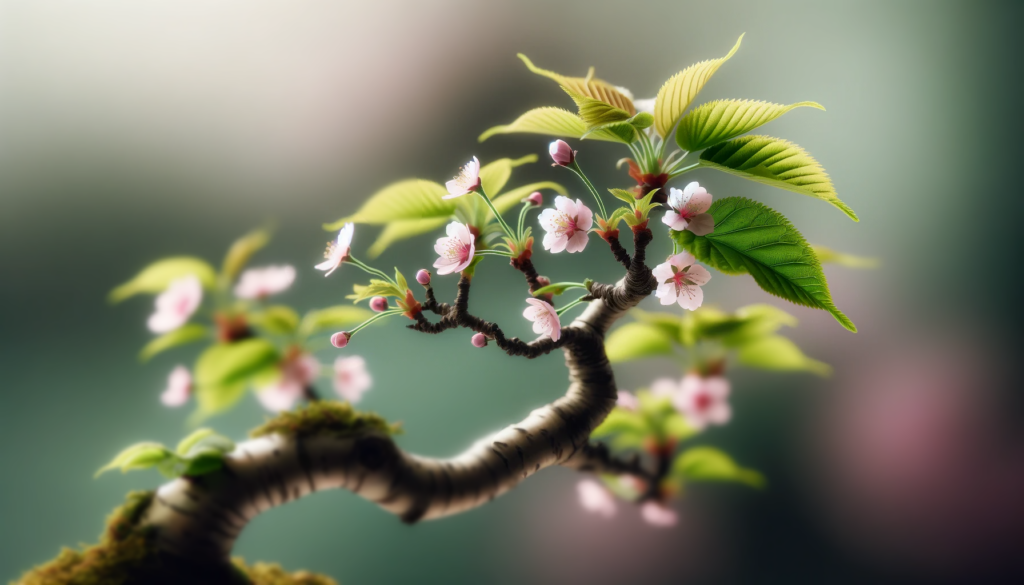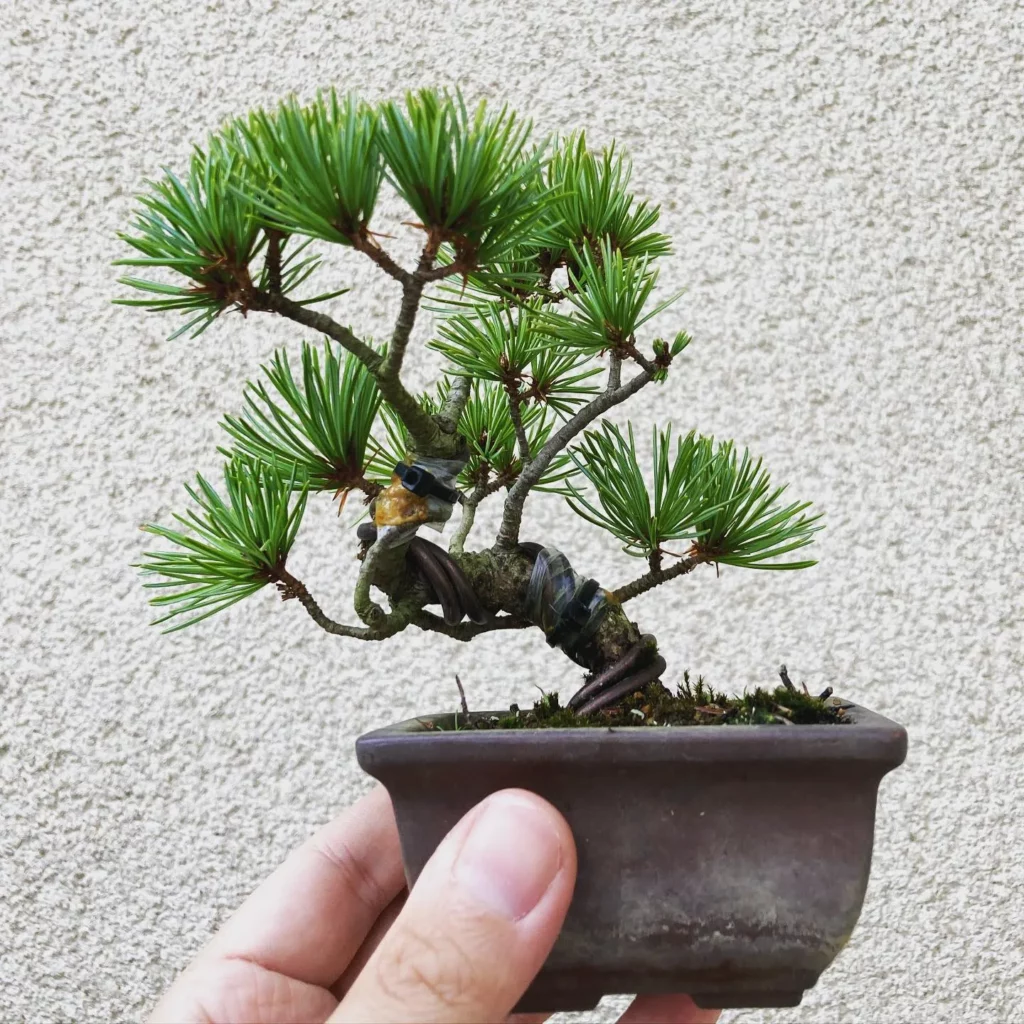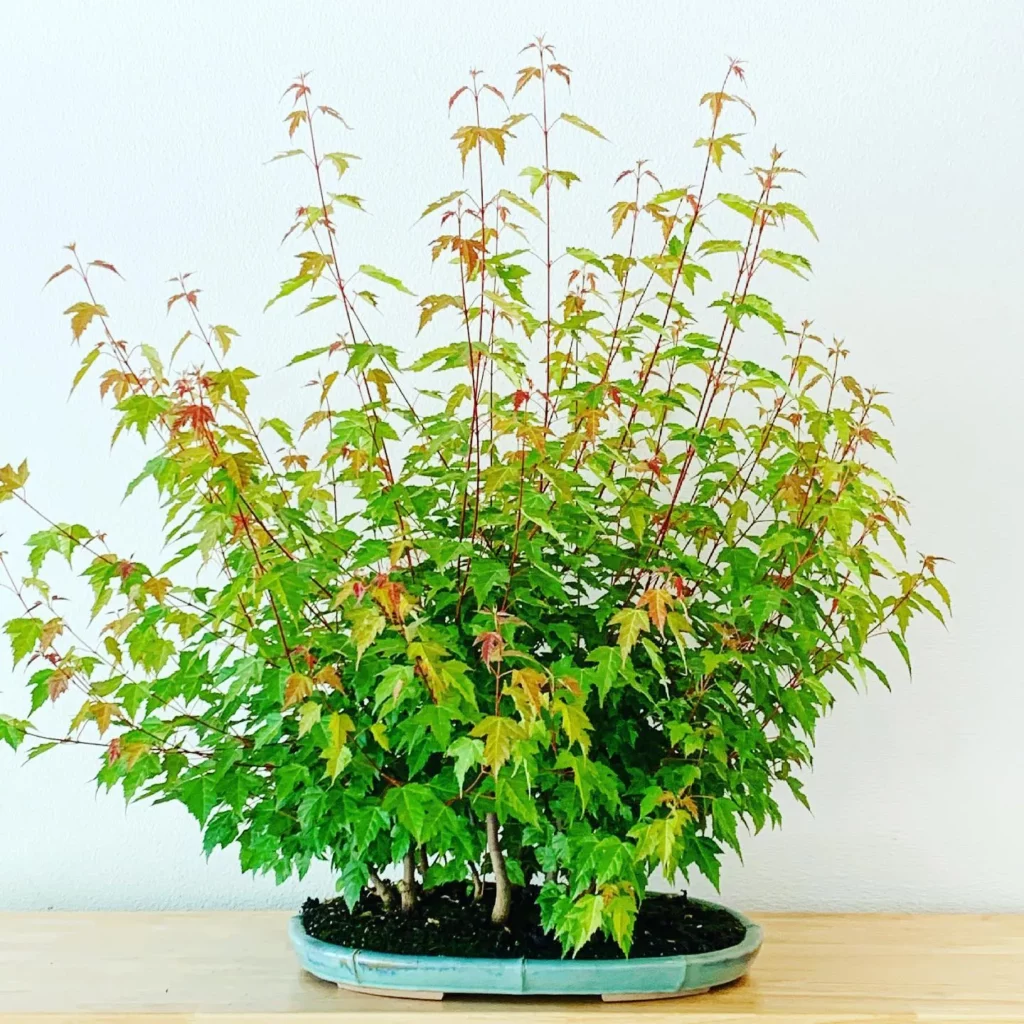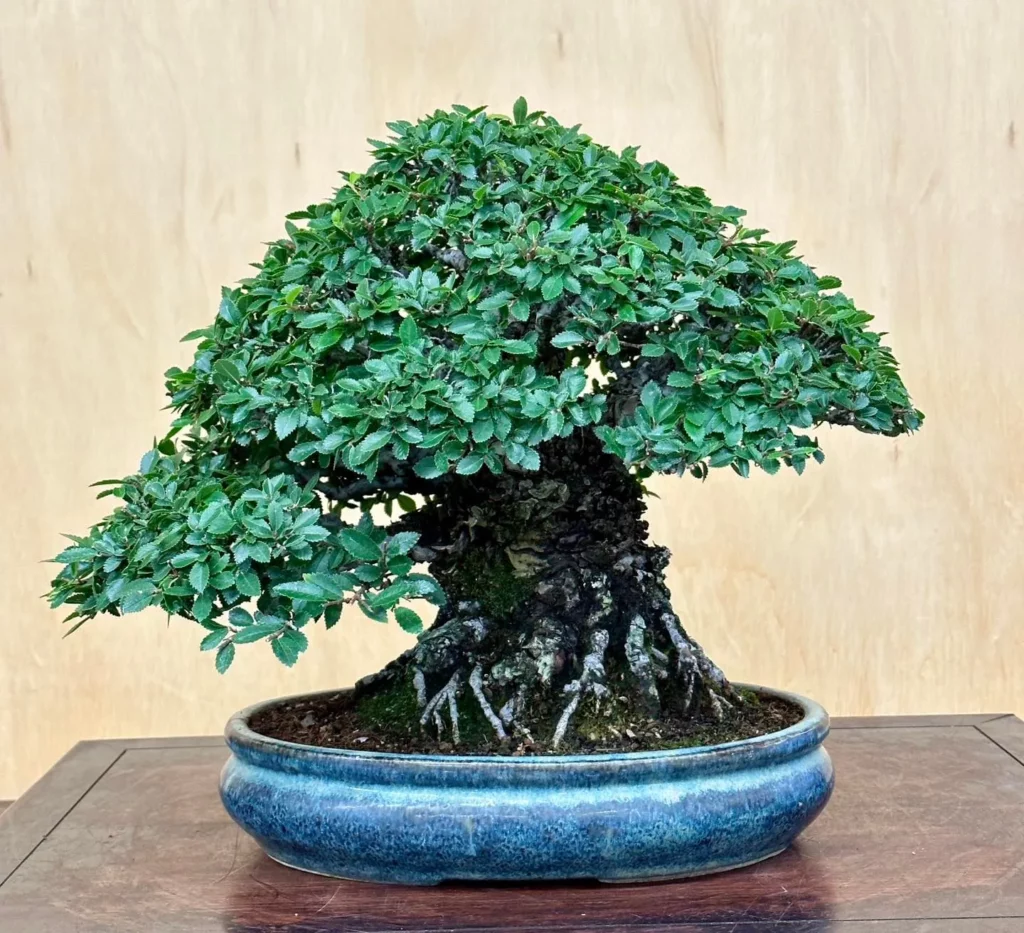Cherry blossoms (sakura) have long been revered for their breathtaking beauty and the symbolism they hold in Japanese culture. These delicate and ethereal flowers represent the transient nature of life, the renewal of the seasons, and the harmony between humans and nature.
🌸🖌️ In this Cherry Blossom care guide, we discuss the art and history of cherry blossom bonsai, exploring its cultural significance and providing beginner-friendly instructions for taking care of these captivating trees.
What is Cherry Blossom Bonsai?



Cherry Blossom Bonsai is the fascinating practice of growing tiny cherry blossom trees using the traditional Japanese art of bonsai. It involves cultivating miniature versions of these beautiful trees to capture and showcase the enchanting beauty of the famous pink or white cherry blossom flowers.
In this art form, every detail matters as plant lovers carefully care for and shape the trees to achieve a smaller yet equally captivating representation of their natural beauty.
No products found.
History and Origins of the Cherry Blossom Bonsai



The Cherry Blossom Bonsai has a long and interesting history that dates back to Japanese culture and the ancient art of bonsai cultivation. Bonsai, the art of growing small trees, originated in China over a thousand years ago but was later adopted and popularized by the Japanese.
Cherry blossoms, known as “sakura” in Japanese, have been highly significant in Japanese culture for a long time. The beauty of cherry blossoms and their short life span serve as a reminder of the transient nature of life.
Adding cherry blossom trees to the bonsai practice was a natural extension, combining the beauty of nature with the art of cultivation. Cherry Blossom Bonsai reflects a deep cultural respect for nature and showcases the ability to find beauty in a small space. Over time, this practice has become popular worldwide, with bonsai enthusiasts cherishing not only the visual beauty of these miniature trees but also the cultural and spiritual meanings they hold.
Cherry Blossom Bonsai and Their Symbolism



Cherry Blossom Bonsai holds deep symbolism, reflecting the cultural heritage and significance of cherry blossoms in Japan. Each aspect of Cherry Blossom Bonsai carries meaning and represents values cherished by the Japanese culture.
- The transience of cherry blossoms symbolizes the fleeting nature of life itself, reminding us to appreciate the present moment and find beauty in impermanence.
- The renewal represented by the blossoms’ annual return showcases the cycle of life and holds the promise of new beginnings.
- The delicate beauty of the cherry blossoms reflects the aesthetics valued in Japanese art and design.
- Cultivating cherry blossom bonsai exemplifies the harmony with nature that is deeply ingrained in Japanese culture.
- Cherry Blossom Bonsai is celebrated as a cultural and seasonal event in Japan, where the blooming of these trees is accompanied by festivals and gatherings that showcase the appreciation of nature’s beauty.
Characteristics of the Cherry Blossom Bonsai



Cherry Blossom Bonsai trees have distinct characteristics that make them visually stunning.
Appearance:
The delicate and elegant cherry blossom flowers are the highlight of the Cherry Blossom Bonsai. They come in beautiful shades of pink and white, creating a captivating sight when in full bloom. The flowers are small in size but abundant in quantity, forming dense clusters that cover the entire tree.
Size:
Cherry Blossom Bonsai trees are miniaturized versions of their full-sized counterparts. They are carefully cultivated to maintain a compact size, making them perfect for indoor spaces such as apartments and offices. Despite their small stature, these bonsai trees exude a sense of grace and beauty.
Branches and Leaves:
The branches of the Cherry Blossom Bonsai are intricately shaped using pruning techniques to create a balanced and natural appearance. The leaves are small and ovate, adding to the overall charm of the tree. During the blooming season, the leaves provide a lush backdrop to the vibrant cherry blossom flowers.
Care:
Proper care is essential to ensure the health and vitality of your Cherry Blossom Bonsai. It requires regular watering, but it’s important not to overwater, as it can lead to root rot. Finding the right balance of moisture is crucial. Providing adequate sunlight is also crucial for the tree’s growth and flowering.
How to Grow Cherry Blossom Bonsai



Growing a beautiful Cherry Blossom Bonsai requires careful attention to detail and following specific steps. By following these guidelines, you can cultivate your own stunning cherry blossom bonsai tree.
Species Selection
Begin by selecting the right species of cherry blossom tree for your bonsai. Some popular choices include Prunus serrulata and Prunus yedoensis. Research the specific characteristics and care requirements of each species to find the best fit for your bonsai collection.
Pot Selection
Choose a suitable pot that is proportionate to the size of your bonsai tree. The pot should have good drainage and be made of a durable material, such as ceramic or clay, to ensure proper moisture retention and airflow.
Soil
Use well-draining bonsai soil to promote healthy root growth and prevent waterlogged roots. A mixture of Akadama, pumice, and lava rock is commonly used for cherry blossom bonsai. Ensure that the soil pH is slightly acidic, as cherry blossom trees prefer this type of environment.
Watering
Proper watering is essential for the health of your cherry blossom bonsai. Water the tree when the soil feels slightly dry, but avoid overwatering. Ensure that the water reaches all parts of the root system evenly.
Lighting
Place your cherry blossom bonsai in a location that receives bright, indirect sunlight. Cherry blossom trees need several hours of sunlight each day to thrive. Consider using grow lights if natural sunlight is limited.
Temperature
Maintain a moderate temperature range for your cherry blossom bonsai, ideally between 60°F and 75°F (15°C and 24°C). Avoid exposing the tree to extreme temperature fluctuations, as it can negatively impact its health.
Pruning
Regular pruning is crucial for maintaining the desired shape and size of your cherry blossom bonsai. Prune branches and leaves carefully to promote balanced growth and enhance the tree’s aesthetic appeal. Remember to use clean, sharp bonsai tools to avoid unnecessary damage to the tree.
Fertilizing
Feed your cherry blossom bonsai with a balanced bonsai fertilizer during the growing season. Follow the manufacturer’s instructions for application and dosage. Fertilizing will provide essential nutrients for healthy growth and vibrant blooms.
Disease and Pest Control
Monitor your cherry blossom bonsai regularly for any signs of pests or diseases. Treat any issues promptly using appropriate methods, such as organic insecticides or fungicides. Maintaining a clean and well-ventilated growing environment can help prevent common bonsai issues.
Growing Cherry Blossom Bonsai from Seeds



If you’re feeling adventurous and want to start your cherry blossom bonsai journey from scratch, you can grow cherry blossom bonsai trees from seeds. While it requires patience and dedication, growing from seeds allows you to witness the full life cycle of these beautiful trees. Here are the steps to grow cherry blossom bonsai from seeds:
🌸 Choosing the Right Species: 🤔 Research and select the perfect cherry blossom species for your location and preferences, like Yoshino cherry, Kwanzan cherry, or Japanese flowering cherry.
Pot Selection: 🍃 Opt for shallow bonsai pots with proper drainage holes for aeration. Clay or ceramic pots work best.
🏞️ Preparing the Soil: 🌱 Use well-draining bonsai soil or a mix of organic soil, sand, and perlite. Sieve the soil to remove large particles.
🌱 Planting the Seeds: ✋ Gently sow the cherry blossom seeds on the soil surface, ensuring they’re evenly spaced. Lightly cover with sieved soil (about twice the seed’s thickness). 💦 Mist the soil to keep it moist.
🏡 Creating the Right Environment: ☀️ Place pots in bright, indirect sunlight and maintain a consistent temperature around 60°F (15°C). Consider using a plastic dome or wrap for a greenhouse effect. 🌱
💧 Watering and Care: 💧 Keep the soil evenly moist, but avoid overwatering to prevent root rot. Use a spray bottle to mist the soil when it starts to dry out.
✂️ Pruning and Shaping: 🌳 As your cherry blossom bonsai grows, prune and shape it regularly to achieve the desired structure. Trim unwanted branches and encourage lateral growth for a balanced and beautiful bonsai tree. 🌸✨
🌿 Fertilizing: 🌱 Bonsai benefit from regular fertilization during the growing season. Use balanced, slow-release bonsai fertilizer or diluted liquid fertilizer according to instructions.
🌰 Stratification: ❄️ Some seeds may need cold stratification. Place them in a moist paper towel in a sealed bag and refrigerate for a few weeks before planting.
Repotting: 🌿 Repot your bonsai every few years during the spring to refresh the soil and provide space for root growth.
🔗 Wiring: 🌳 Use soft aluminum or copper wire to gently shape your bonsai branches. Be careful not to wrap it too tightly.
Pest and Disease Control: 🐜 Watch out for pests and diseases; treat them promptly with the right solutions when spotted.
❄️ Winter Care: 🌨️ Protect your bonsai from extreme cold during winter. Consider sheltering or covering it to prevent frost damage.
⏳ Patience: 🕰️ Growing a cherry blossom bonsai takes time. Be patient and enjoy the journey.
🌱 Training: ✂️ Continuously prune, wire, and shape your bonsai as it matures to maintain its form and beauty.
📚 Learn and Adapt: 🧠 Keep learning from experiences, books, and online resources. Consider joining a bonsai club for insights from experts. Be open to adapting your care routine as needed.
Growing a cherry blossom bonsai is a delightful journey that requires dedication, learning, and patience. Enjoy the process and watch your bonsai blossom into a work of art! 🌸🌳😊
Sakura Bonsai Trees Around the World



Sakura bonsai trees can be found around the world, bringing the beauty of these delicate flowers to different regions. In the United States, cherry blossoms have been planted in various locations, allowing people to experience the enchantment of sakura bonsai close to home.
One notable location to admire cherry blossoms in the United States is Washington, DC, where they were thoughtfully planted on the shores of the Tidal Basin. Every spring, these blooming trees create a breathtaking display of pink and white flowers, attracting visitors from near and far.
Additionally, Sakura Park in Manhattan and Philadelphia also feature cherry blossom trees, allowing residents and visitors to immerse themselves in the beauty of sakura bonsai.
However, the largest collection of cherry blossoms in the United States can be found in Branch Brook Park, located in Newark, New Jersey. With approximately 4,300 cherry blossom trees, this park is a must-visit for any sakura bonsai enthusiast, offering a stunning spectacle of nature’s beauty.
Sakura Bonsai Trees in International Settings
The popularity of sakura bonsai extends beyond the United States. These captivating trees can be found in various international locations, allowing people all over the world to enjoy their splendor. Japan, the birthplace of cherry blossoms, naturally boasts an abundance of sakura bonsai trees. Visitors to Japan can witness these iconic trees in locations such as parks, gardens, and temple grounds, providing a truly immersive experience into the country’s rich cultural heritage.
China also cultivates sakura bonsai. Gardens and botanical centers in China showcase these miniature trees, honoring the beauty and symbolism of cherry blossoms.
Medicinal Uses and Cultivation Tips
Sakura bonsai trees, also known as cherry blossom bonsai, have a long history of being used for their medicinal purposes throughout Asia. These miniature trees are believed to offer various health benefits:
- Relief for coughs and colds: Sakura bonsai trees have been traditionally used to help alleviate symptoms of coughs and colds. The flowers and leaves of the tree are infused into teas or consumed as herbal remedies.
- Promotion of heart health: Cherry blossom bonsai is known for its high vitamin C content, which is essential for cardiovascular health. Including sakura bonsai in your garden can promote heart health and overall well-being.
- Boosting the immune system: Vitamin C, found abundantly in sakura bonsai, is a powerful antioxidant that aids in boosting the immune system. Consuming or inhaling the scent of cherry blossoms may help strengthen your body’s defense against diseases and infections.
- Reducing fevers: The leaves and flowers of the sakura bonsai tree are believed to have antipyretic properties, making them effective in reducing fevers. The leaves can be dried, ground into a powder, and used in herbal remedies.
To cultivate healthy and vibrant sakura bonsai, follow these essential cultivation tips:
- Lighting: Provide your sakura bonsai with ample sunlight to ensure proper growth. Place your tree in a location where it receives at least six to eight hours of direct sunlight daily.
- Watering: Maintain consistent moisture levels in the soil by watering your sakura bonsai regularly. It’s crucial to avoid waterlogging the roots, so make sure the soil drains well. Check the moisture level by inserting a finger into the soil; if it feels dry, water the tree.
- Fertilization: Apply a balanced bonsai fertilizer during the growing season to provide essential nutrients for healthy growth. Follow the instructions on the fertilizer packaging for the appropriate dosage and frequency.
- Pruning: Regularly prune your sakura bonsai to maintain its desired shape and prevent excessive growth. Remove any dead or damaged branches, and trim back new growth to maintain an aesthetically pleasing form.
- Disease and pest control: Keep an eye out for common bonsai pests and diseases, such as aphids, spider mites, and fungal infections. Take preventative measures, such as applying insecticides and fungicides, to protect your sakura bonsai.
The Art of Growing Sakura Bonsai
Growing sakura bonsai is not only a horticultural practice but also an art form that requires attention to detail, patience, and dedication. Cultivating these miniature trees allows enthusiasts to appreciate the beauty of cherry blossoms on a smaller scale.
By carefully shaping and maintaining the tree’s form, bonsai growers create living works of art that embody the spirit and cultural significance of cherry blossoms. Each branch and leaf is meticulously pruned and positioned to create a harmonious composition that reflects the beauty found in nature.
Attention to detail is key in the art of cultivating sakura bonsai. It involves choosing the right species, selecting suitable pots, and creating the perfect soil composition to ensure optimal growth and health. Every aspect of care, from watering to fertilizing, requires precision and a keen eye for detail to create a thriving bonsai tree.
Patience is a virtue when it comes to growing sakura bonsai. It takes years, even decades, for a bonsai tree to reach its full potential. The process of carefully shaping the tree and guiding its growth requires unwavering dedication and a long-term perspective. It is through this patient cultivation that the beauty of cherry blossoms can be captured in miniature form.
The art of growing sakura bonsai goes beyond mere horticulture. It allows individuals to connect with nature on a deeper level, channel their creativity, and create living masterpieces that evoke the beauty and symbolism of cherry blossoms. It is a rewarding and fulfilling journey for those who are willing to invest their time, passion, and dedication into this ancient art form.
Sakura Cherry Blossom Bonsai Watering Needs
Proper watering is crucial for the health and vitality of your Sakura Bonsai tree. Understanding the watering needs of your Sakura Bonsai involves considering factors such as soil selection, seasonal variations, and proper watering techniques.
Sakura Bonsai and Soil Selection
Choosing the right soil for your Sakura Bonsai is essential for maintaining its overall health. Opt for well-draining bonsai soil that promotes proper airflow and prevents waterlogged roots. This helps ensure that your tree receives adequate moisture without being overly saturated.
Seasonal Variations in Watering
As the seasons change, so do the watering requirements of your Sakura Bonsai. During the growing season, which is typically from spring to fall, your tree will require more frequent watering to support its active growth. In contrast, during the dormant period in winter, you’ll need to reduce the frequency of watering as the tree’s water requirements decrease.
Watering Techniques for Sakura Bonsai
When watering your Sakura Bonsai, it’s important to strike the right balance between keeping the soil slightly moist and avoiding waterlogging. Here are some techniques to follow:
- Use a watering can or spray bottle to water your tree gently. Avoid strong water pressure, as it can disrupt the delicate roots.
- Water the soil, rather than the leaves or flowers, to prevent disease and promote optimal root health.
- Monitor the moisture level of your Sakura Bonsai’s soil regularly. Stick your finger about an inch into the soil to check for moisture. If it feels slightly moist, then the watering is sufficient. If it feels dry, it’s time to water.
- Avoid overwatering, as it can lead to root rot and other issues. Allow the soil to dry out slightly between watering sessions.
- Consider using a humidity tray or misting the leaves occasionally to increase humidity levels, especially in dry climates.
Conclusion
Sakura Bonsai, also known as Cherry Blossom Bonsai, is a captivating art that brings the beauty of cherry blossoms into a miniature form. These enchanting trees not only showcase the transient nature of life but also hold deep cultural significance in Japan. By following specific cultivation tips and techniques, such as species selection, proper soil and pot choice, watering, lighting, pruning, and fertilizing, bonsai enthusiasts can create their own living masterpieces.
Cultivating a Sakura Bonsai requires attention to detail and care, but the rewards are truly worth it. These miniature trees reflect the rich cultural heritage of Japan and bring a touch of elegance and tranquility to any space. Whether it’s displaying them in your home or tending to a bonsai garden, the beauty and symbolism of cherry blossoms will never fail to captivate and inspire.
As you embark on your Sakura Bonsai journey, remember to embrace the delicate balance between beauty and cultivation. With patience and dedication, you can create a serene oasis that celebrates the timeless allure of cherry blossoms. So why not start your own Sakura Bonsai today and witness the breathtaking beauty unfold in your own surroundings?
FAQ
What is Cherry Blossom Bonsai?
Cherry Blossom Bonsai is the practice of growing miniature cherry blossom trees using the Japanese art of bonsai cultivation. It aims to create a living piece of art that represents the beauty of the iconic pink or white cherry blossom flowers.
What is the history and origin of Cherry Blossom Bonsai?
Cherry Blossom Bonsai has a deep history that dates back to Japanese culture and the ancient art of bonsai cultivation. Bonsai originated in China over a thousand years ago and was later popularized by the Japanese. The addition of cherry blossoms to the bonsai practice combines the beauty of nature with the art of cultivation, reflecting a cultural respect for nature and the ability to find beauty in a small space.
What does Cherry Blossom Bonsai symbolize?
Cherry Blossom Bonsai carries deep symbolism, reflecting the cultural importance of cherry blossoms in Japan and the skill required to cultivate bonsai trees. It represents the transience of life, the beauty of nature, and the rich cultural heritage of Japan. Growing and caring for cherry blossom bonsai is a celebration of harmony with nature and the renewal of life.
What are the characteristics of the Cherry Blossom Bonsai?
Cherry Blossom Bonsai trees, also known as “Sakura” in Japan, have distinct characteristics that make them visually stunning. They have delicate, small flowers that can be pink or white, along with small and compact leaves. The branches are artfully shaped to mimic the natural growth patterns of cherry blossom trees.
How do I grow Cherry Blossom Bonsai?
Growing a cherry blossom bonsai requires attention to detail and specific steps. It involves selecting the right tree species, pot, soil, and providing appropriate watering, lighting, temperature, pruning, fertilizing, and disease and pest control. Following these steps and caring for the bonsai will help you grow a beautiful and healthy cherry blossom bonsai.
Can I grow Cherry Blossom Bonsai from seeds?
Yes, it is possible to grow cherry blossom bonsai trees from seeds. To do so, you need to select the right tree species, pot, and soil, and follow specific steps including watering, lighting, temperature, and pruning. With patience and care, you can grow a cherry blossom bonsai from seeds.
Where can I find Sakura Bonsai trees?
Sakura bonsai trees can be found around the world. In the United States, cherry blossoms can be seen in various locations, such as Washington, DC, Sakura Park in Manhattan, and Philadelphia. However, the largest collection of cherry blossoms can be found in Branch Brook Park in Newark, New Jersey, with approximately 4,300 trees.
Are there any medicinal uses for Sakura Bonsai trees?
Sakura bonsai trees have been traditionally used for medicinal purposes throughout Asia. They are believed to help with coughs and colds, reduce fevers, and improve heart health due to their high vitamin C content. However, the flowers should be consumed in moderation due to a certain level of toxicity.
What is the art of growing Sakura Bonsai?
Growing Sakura Bonsai is not just a horticultural practice but also an art form that requires attention to detail, patience, and dedication. By carefully shaping and maintaining the tree’s form, bonsai growers create living works of art that embody the spirit and cultural significance of cherry blossoms.
What are the watering needs of Sakura Bonsai trees?
Proper watering is crucial for the health of a Sakura Bonsai tree. The watering needs depend on factors like the type of soil and the specific requirements of the tree. Well-draining bonsai soil and pots with drainage holes are vital to prevent waterlogged roots. The timing and frequency of watering may vary with the changing seasons. Regular monitoring of the soil’s moisture level and adjusting watering techniques accordingly will help ensure optimal growth and health.
How do I care for Sakura Bonsai?
Caring for Sakura Bonsai involves various aspects such as species selection, pot selection, soil, watering, lighting, temperature, pruning, fertilizing, and disease and pest control. By following specific care techniques, you can ensure the health and vitality of your Sakura Bonsai tree.






